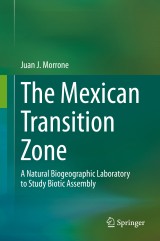Details

The Mexican Transition Zone
A Natural Biogeographic Laboratory to Study Biotic Assembly|
139,09 € |
|
| Verlag: | Springer |
| Format: | |
| Veröffentl.: | 02.07.2020 |
| ISBN/EAN: | 9783030479176 |
| Sprache: | englisch |
Dieses eBook enthält ein Wasserzeichen.
Beschreibungen
<p>This book presents an evolutionary biogeographic analysis of the Mexican Transition Zone, which is situated in the overlap of the Nearctic and Neotropical regions. It includes a comprehensive review of previous track, cladistic and molecular biogeographic analyses and is illustrated with full color maps and vegetation photographs of the respective areas covered.</p>
<p> </p>
<div>Given its scope, the book will be of interest to students and researchers whose work involves systematic and biogeographic analyses of plant and animal taxa of the Mexican Transition Zone or other transition zones of the world, and to ecologists working in biodiversity conservation, who will be able to appreciate the evolutionary relevance of the Mexican Transition Zone for establishing conservation areas..<br></div>
<p> </p>
<div>Given its scope, the book will be of interest to students and researchers whose work involves systematic and biogeographic analyses of plant and animal taxa of the Mexican Transition Zone or other transition zones of the world, and to ecologists working in biodiversity conservation, who will be able to appreciate the evolutionary relevance of the Mexican Transition Zone for establishing conservation areas..<br></div>
<div>Chapter 1. What is a transition zone?</div><div>An ecological and evolutionary characterization of transition zones, where they are found and how their biotas are assembled.</div><div><br></div><div>Chapter 2. What is evolutionary biogeography?</div><div>A brief characterization of the field of evolutionary biogeography, with a description of the different methods that are currently used.</div><div><br></div><div>Chapter 3. A historical perspective of the Mexican Transition Zone</div><div>A historiographic analysis of the Mexican Transition Zone, detailing the main events and authors that have contributed to it.</div><div><br></div><div>Chapter 4. The cenocrons of the Mexican Transition Zone</div><div>A description of the cenocrons of the Mexican Transition Zone, namely, Paleoamerican, Mexican Plateau, Mountain Mesoamerican, Nearctic and Typical Neotropical. For each cenocron, examples of plant and animal taxa are presented and illustrated. Their historical assembly is also analyzed.</div><div><br></div><div>Chapter 5. Regionalization of the Mexican Transition Zone</div><div>A characterization of the biogeographic provinces recognized for the Mexican Transition Zone, namely, Sierra Madre Occidental, Sierra Madre Oriental, Transmexican Volcanic Belt, Sierra Madre del Sur and Chiapas Highlands. Additionally, examples of plants and animals endemic to each province are provided.</div><div><br></div><div>Chapter 6. Perspectives for the future</div><div>A discussion of the current understanding of biotic assembly in the Mexican Transition Zone and the perspectives for future studies. Additionally, some issues concerning the analysis of transition zones will be discussed.</div>
<div><p><b>Juan J. Morrone</b> is a Professor of Biogeography, Systematics, and Comparative Biology at the Facultad de Ciencias, Universidad Nacional Autónoma de México (UNAM), Mexico City. He has written extensively on biogeography and led more than 110 graduate and postgraduate courses in Mexico, Argentina, Colombia, Ecuador, Brazil, and Spain. He is an editor for several journals, e.g. Cladistics, Mastozoología Neotropical, Acta Entomológica Chilena, Zootaxa and Phytotaxa, and Dugesiana, Hidrobiológica, Revista Mexicana de Biodiversidad, and Acta Zoológica Mexicana. He has published over 250 scientific papers and 30 books on evolutionary biogeography, phylogenetic systematics, biogeographic regionalization and evolution.</p><br></div>
<p>This book presents an evolutionary biogeographic analysis of the Mexican Transition Zone, which is situated in the overlap of the Nearctic and Neotropical regions. It includes a comprehensive review of previous track, cladistic and molecular biogeographic analyses and is illustrated with full color maps and vegetation photographs of the respective areas covered.</p>
<p><br></p><p>Given its scope, the book will be of interest to students and researchers whose work involves systematic and biogeographic analyses of plant and animal taxa of the Mexican Transition Zone or other transition zones of the world, and to ecologists working in biodiversity conservation, who will be able to appreciate the evolutionary relevance of the Mexican Transition Zone for establishing conservation areas.<br></p>
<p><br></p><p>Given its scope, the book will be of interest to students and researchers whose work involves systematic and biogeographic analyses of plant and animal taxa of the Mexican Transition Zone or other transition zones of the world, and to ecologists working in biodiversity conservation, who will be able to appreciate the evolutionary relevance of the Mexican Transition Zone for establishing conservation areas.<br></p>
<p>Offers detailed information on, and analysis of, the Mexican Transition Zone</p><p>Discusses theoretical and practical issues in evolutionary biogeography</p><p>Highlights the relevance of transition zones for studying biotic assemblages</p><p>Draws on extensive distributional data and employs a range of methodologies</p>
Diese Produkte könnten Sie auch interessieren:

Auditory Signal Processing

von: Daniel Pressnitzer, Alain de Cheveigne, Stephen McAdams, Lionel Collet

213,99 €















